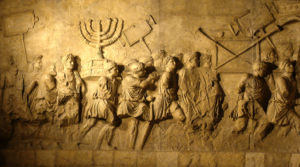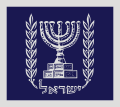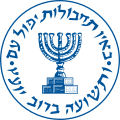Emblem of Israel facts for kids
Quick facts for kids Emblem of Israel |
|
|---|---|
 |
|
| Armiger | |
| Adopted | 10 February 1949 |
| Motto | ישראל (Israel) |
| Constituent parts | Menorah, olive branches |
The Emblem of Israel (Hebrew: סמל מדינת ישראל, romanized: Sēmel Medīnat Yīsrāʾēl) is a special symbol for the country of Israel. It shows a temple menorah, which is a type of candle holder, with an olive branch on each side. Below these symbols, the word "Israel" is written in Hebrew. You often see the emblem in blue and white, but it can also appear in other colors for different uses, like on the flag of the President of Israel.
Contents
History of the Israeli Emblem

The country of Israel chose this symbol after holding a design competition in 1948. The winning design came from Gabriel and Maxim Shamir. However, parts of other ideas were also used to create the final emblem. Many artists, like Oteh Walisch and Willie Wind, helped with their designs. The Emblem of Israel officially became the country's symbol on February 10, 1949.
Symbolism Behind the Emblem
The main image on the emblem is based on a picture of the menorah found on the Arch of Titus. This arch is a famous monument in Rome. The menorah was used in the ancient Temple in Jerusalem a long time ago. It has been an important symbol for Judaism for thousands of years.
What the Menorah Means
The menorah on the emblem represents universal enlightenment. This means it stands for light and knowledge for everyone. This idea comes from an ancient text, Isaiah 60, which talks about nations coming to a great light.
The Meaning of Olive Branches
The two olive branches on each side of the menorah are also very important. They often symbolize peace and hope. Some people believe the emblem's design also comes from a vision by the prophet Zechariah. In his vision, he saw a menorah with two olive trees next to it.
How the Emblem is Used
The Emblem of Israel is used in many official places. You can see it on government buildings and documents. It also appears on flags and passports. The emblem helps to show that something belongs to the State of Israel.
The following gallery shows various contexts in which the emblem is used:
-
Standard of the President of Israel
-
Flag and emblem of Israel banners decorate a house on Israel Independence Day (2007)
See also
 In Spanish: Emblema nacional de Israel para niños
In Spanish: Emblema nacional de Israel para niños






